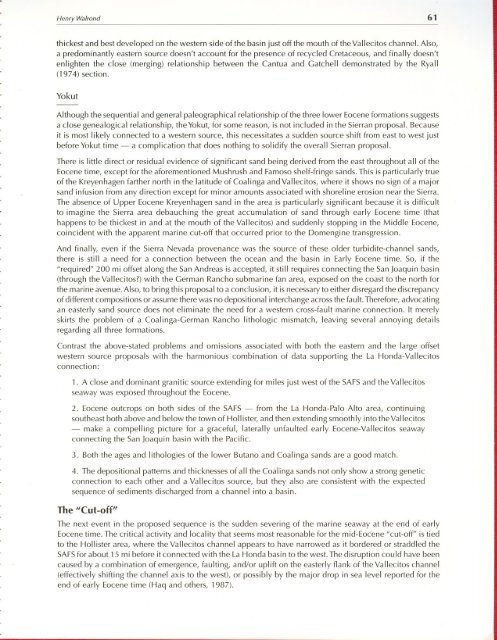A Tale of Two Eocene Sands - San Joaquin Valley Geology
A Tale of Two Eocene Sands - San Joaquin Valley Geology
A Tale of Two Eocene Sands - San Joaquin Valley Geology
Create successful ePaper yourself
Turn your PDF publications into a flip-book with our unique Google optimized e-Paper software.
Henry Walrond 61<br />
thickest and best developed on the western side <strong>of</strong> the basin just <strong>of</strong>f the mouth <strong>of</strong> the Vallecitos channel. Also,<br />
a predominantly eastern source doesn't account for the presence <strong>of</strong> recycled Cretaceous, and finally doesn't<br />
enlighten the close (merging) relationship between the Cantua and Gatchell demonstrated by the Ryall<br />
(1974) section.<br />
Yokut<br />
Although the sequential and general paleographical relationship <strong>of</strong> the three lower <strong>Eocene</strong> formations suggests<br />
a close genealogical relationship, the Yokut, for some reason, is not included in the Sierran proposal. Because<br />
it is most likely connected to a western source, this necessitates a sudden source shift from east to west just<br />
before Yokut time - a complication that does nothing to solidify the overall Sierran proposal.<br />
There is little direct or residual evidence <strong>of</strong> significant sand being derived from the east throughout all <strong>of</strong> the<br />
<strong>Eocene</strong> time, except for the aforementioned Mushrush and Famoso shelf-fringe sands. This is particularly true<br />
<strong>of</strong> the Kreyenhagen farther north in the latitude <strong>of</strong> Coalinga and Vallecitos, where it shows no sign <strong>of</strong> a major<br />
sand infusion from any direction except for minor amounts associated with shoreline erosion near the Sierra.<br />
The absence <strong>of</strong> Upper <strong>Eocene</strong> Kreyenhagen sand in the area is particularly significant because it is difficult<br />
to imagine the Sierra area debauching the great accumulation <strong>of</strong> sand through early <strong>Eocene</strong> time (that<br />
happens to be thickest in and at the mouth <strong>of</strong> the Vallecitos) and suddenly stopping in the Middle <strong>Eocene</strong>,<br />
coincident with the apparent marine cut-<strong>of</strong>f that occurred prior to the Domengine transgression.<br />
And finally, even if the Sierra Nevada provenance was the source <strong>of</strong> these older turbidite-channel sands,<br />
there is still a need for a connection between the ocean and the basin in Early <strong>Eocene</strong> time. So, if the<br />
"required" 200 mi <strong>of</strong>fset along the <strong>San</strong> Andreas is accepted, it still requires connecting the <strong>San</strong> <strong>Joaquin</strong> basin<br />
(through the Vallecitos?) with the German Rancho submarine fan area, exposed on the coast to the north for<br />
the marine avenue. Also, to bring this proposal to a conclusion, it is necessary to either disregard the discrepancy<br />
<strong>of</strong> different compositions or assume there was no depositional interchange across the fault. Therefore, advocating<br />
an easterly sand source does not eliminate the need for a western cross-fault marine connection. It merely<br />
skirts the problem <strong>of</strong> a Coalinga-German Rancho lithologic mismatch, leaving several annoying details<br />
regarding all three formations.<br />
Contrast the above-stated problems and omissions associated with both the eastern and the large <strong>of</strong>fset<br />
western source proposals with the harmonious combination <strong>of</strong> data supporting the La Honda-Vallecitos<br />
connection:<br />
1. A close and dominant granitic source extending for miles just west <strong>of</strong> the SAFS and the Vallecitos<br />
seaway was exposed throughout the <strong>Eocene</strong>.<br />
2. <strong>Eocene</strong> outcrops on both sides <strong>of</strong> the SAFS - from the La Honda-Palo Alto area, continuing<br />
southeast both above and below the town <strong>of</strong> Hollister, and then extending smoothly into the Vallecitos<br />
- make a compelling picture for a graceful, laterally unfaulted early <strong>Eocene</strong>-Vallecitos seaway<br />
connecting the <strong>San</strong> <strong>Joaquin</strong> basin with the Pacific.<br />
3. Both the ages and lithologies <strong>of</strong> the lower Butano and Coalinga sands are a good match.<br />
4. The depositional patterns and thicknesses <strong>of</strong> all the Coalinga sands not only show a strong genetic<br />
connection to each other and a Vallecitos source, but they also are consistent with the expected<br />
sequence <strong>of</strong> sediments discharged from a channel into a basin.<br />
The "Cut-<strong>of</strong>f"<br />
The next event in the proposed sequence is the sudden severing <strong>of</strong> the marine seaway at the end <strong>of</strong> early<br />
<strong>Eocene</strong> time. The critical activity and locality that seems most reasonable for the mid-<strong>Eocene</strong> "cut-<strong>of</strong>f" is tied<br />
to the Hollister area, where the Vallecitos channel appears to have narrowed as it bordered or straddled the<br />
SAFSfor about 15 mi before it connected with the La Honda basin to the west. The disruption could have been<br />
caused by a combination <strong>of</strong> emergence, faulting, and/or uplift on the easterly flank <strong>of</strong> the Vallecitos channel<br />
(effectively shifting the channel axis to the west), or possibly by the major drop in sea level reported for the<br />
end <strong>of</strong> early <strong>Eocene</strong> time (Haq and others, 1987).


